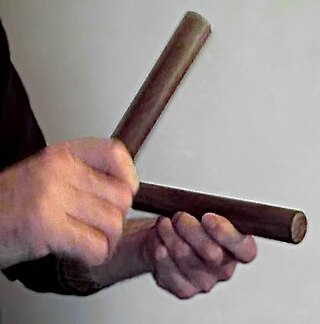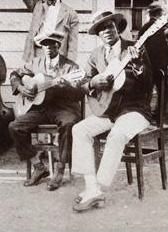There are many styles of traditional and modern music of Ghana, due to Ghana's worldwide geographic position on the African continent.

The clave is a rhythmic pattern used as a tool for temporal organization in Brazilian and Cuban music. In Spanish, clave literally means key, clef, code, or keystone. It is present in a variety of genres such as Abakuá music, rumba, conga, son, mambo, salsa, songo, timba and Afro-Cuban jazz. The five-stroke clave pattern represents the structural core of many Cuban rhythms. The study of rhythmic methodology, especially in the context of Afro-Cuban music, and how it influences the mood of a piece is known as clave theory.

Osibisa are a British-Ghanaian-Caribbean Afro-rock band founded in London in the late 1960s by four expatriate West African and three London based Caribbean musicians.
Guy Warren of Ghana, also known as Kofi Ghanaba, was a Ghanaian musician, most notable as the inventor of Afro-jazz — "the reuniting of African-American jazz with its African roots" — and as a member of The Tempos, alongside E. T. Mensah. He also inspired musicians such as Fela Kuti. Warren's virtuosity on the African drums earned him the appellation "The Divine Drummer". At different stages of his life, he additionally worked as a journalist, DJ and broadcaster.
Palm-wine music is a West African musical genre. It evolved among the Kru people of Liberia and Sierra Leone, who used Portuguese guitars brought by sailors, combining local melodies and rhythms with Trinidadian calypso to create a "light, easy, lilting style". It would initially work its way inland where it would adopt a more traditional style than what was played in coastal areas.

African popular music, like African traditional music, is vast and varied. Most contemporary genres of African popular music build on cross-pollination with Western popular music. Many genres of popular music like blues, jazz, salsa, zouk, and rumba derive to varying degrees on musical traditions from Africa, taken to the Americas by enslaved Africans. These rhythms and sounds have subsequently been adapted by newer genres like rock, and rhythm and blues. Likewise, African popular music has adopted elements, particularly the musical instruments and recording studio techniques of the Western music industry. The term does not refer to a specific style or sound but is used as a general term for African popular music.
Hiplife is a Ghanaian musical style that fuses Ghanaian culture and hip hop. Recorded predominantly in the Ghanaian Akan language, hiplife is rapidly gaining popularity in the 2010s throughout West Africa and abroad, especially in the United Kingdom, United States, Canada and Germany.

The music of West Africa has a significant history, and its varied sounds reflect the wide range of influences from the area's regions and historical periods.
Afro rock is a style of rock music with African influences. Afro rock is a dynamic interplay between Western rock music and African musical elements such as rhythm, melodies and instrumentation. Afro rock bands and artists in the late 1960s and early 1970s included Osibisa, Assagai and Lafayette Afro Rock Band.

John Collins is a UK-born guitarist, harmonica player and percussionist who first went to Ghana as a child in 1952 for a brief period and later became involved in the West African music scene after returning to Ghana in 1969. He is a naturalised Ghanaian.

Soul to Soul is a 1971 documentary film about the Independence Day concert held in Accra, Ghana, on 6 March 1971. It features an array of mostly American R&B, soul, rock, and jazz musicians.
Emmanuel Tettey Mensah, was a Ghanaian musician who was regarded as the "King of Highlife" music. He led The Tempos, a band that toured widely in West Africa.
Victor Abimbola Olaiya, , also known as Dr Victor Olaiya, was a Nigerian trumpeter who played in the highlife style. Though famous in Nigeria during the 1950s and early 1960s, Olaiya received little recognition outside his native country. Alhaji Alade Odunewu of the Daily Times called him "The Evil Genius of Highlife."
Wulomei is a Ghanaian music group that was founded in 1973 by Nii Tei Ashitey, with the encouragement of the dramatist and musician Saka Acquaye. Acquaye managed the band and wrote some of the music.

A guajeo is a typical Cuban ostinato melody, most often consisting of arpeggiated chords in syncopated patterns. Some musicians only use the term guajeo for ostinato patterns played specifically by a tres, piano, an instrument of the violin family, or saxophones. Piano guajeos are one of the most recognizable elements of modern-day salsa. Piano guajeos are also known as montunos in North America, or tumbaos in the contemporary Cuban dance music timba.
John William Hansen popularly known as Jerry Hansen was a Ghanaian highlife musician. He was a singer, a composer, an arranger, a saxophonist and a pioneer of highlife music. He was the bandleader and founder of the Ramblers International Band. He was a founding member and the first president of the Musicians Union of Ghana (MUSIGA).
Ghanaian highlife emerged in the 1980s as a mixture of West African rhythms from Europe by Black people from south and North America. There were three forms of Ghanaian highlife:
Emmanuel Kofi Nyame, best known as E.K. Nyame, was regarded as one of the "godfathers" of modern Ghanaian highlife music. He was a Ghanaian composer, guitarist, founder of E.K. band and the Akan Trio. He is noted as the pioneer of highlife songs in Akan language on concert stages.
The Adaha was type of highlife that was played on flutes, fifes, and brass band drums which originated in Ghana in the 19th century and then spread across West Africa during the 1930s
Kwame Gyasi (1929–2012) was a Ghanaian highlife musician. He originated the Sikyi highlife sub-genre which combined electric organ with the known highlife genres.








